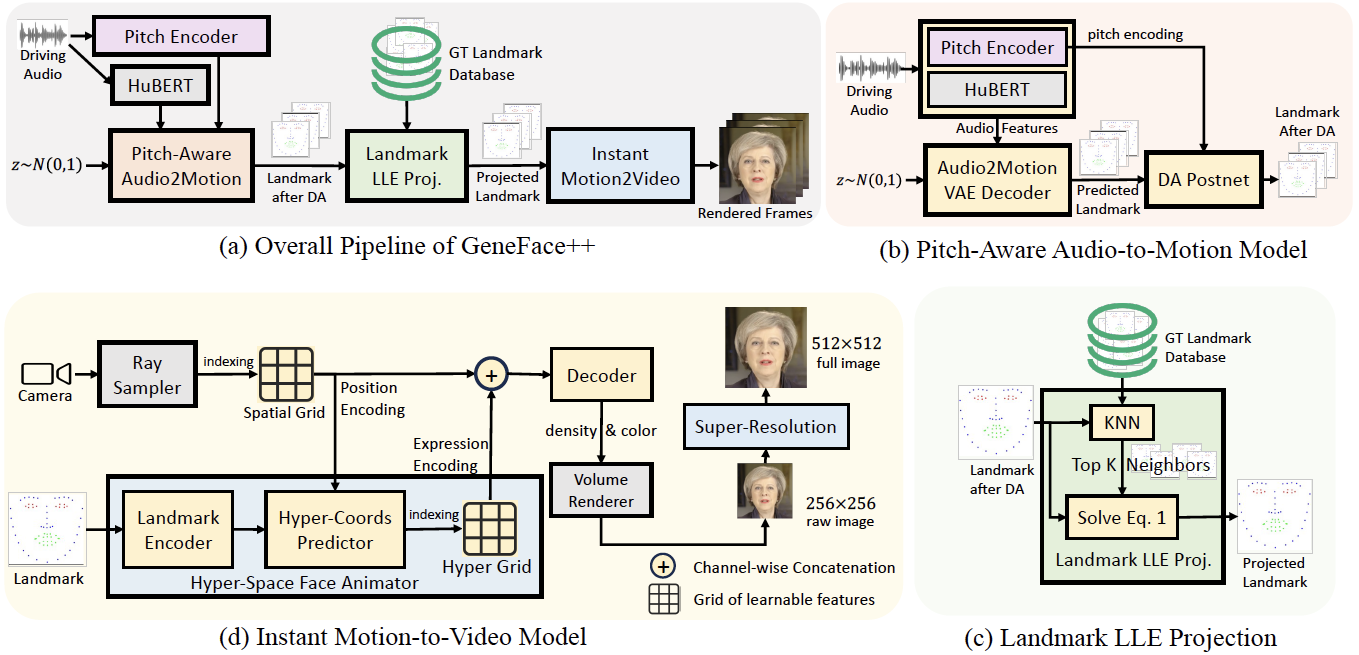

This is the official implementation of GeneFace++ Paper with Pytorch, which enables high lip-sync, high video-reality and high system-efficiency 3D talking face generation. You can visit our Demo Page to watch demo videos and learn more details.
The eye blink control is an experimental feature, and we are currently working on improving its robustness. Thanks for your patience.
- We release Real3D-portrait (ICLR 2024 Spotlight), (https://github.com/yerfor/Real3DPortrait), a NeRF-based one-shot talking face system. Only upload one image and enjoy realistic talking face!
We provide a guide for a quick start in GeneFace++.
-
Step 1: Follow the steps in
docs/prepare_env/install_guide.md, create a new python environment namedgeneface, and download 3DMM files intodeep_3drecib/BFM. -
Step 2: Download pre-processed dataset of May(Google Drive or BaiduYun Disk with password 98n4), and place it here
data/binary/videos/May/trainval_dataset.npy -
Step 3: Download pre-trained audio-to-motino model
audio2motion_vae.zip(Google Drive or BaiduYun Disk with password 9cqp) and motion-to-video checkpointmotion2video_nerf.zip, which is specific to May (in this Google Drive or in thisBaiduYun Disk with password 98n4), and unzip them to./checkpoints/
After these steps,your directories checkpoints and data should be like this:
> checkpoints
> audio2motion_vae
> motion2video_nerf
> may_head
> may_torso
> data
> binary
> videos
> May
trainval_dataset.npy
- Step 4: activate
genefacePython environment, and execute:
export PYTHONPATH=./
python inference/genefacepp_infer.py --a2m_ckpt=checkpoints/audio2motion_vae --head_ckpt= --torso_ckpt=checkpoints/motion2video_nerf/may_torso --drv_aud=data/raw/val_wavs/MacronSpeech.wav --out_name=may_demo.mp4Or you can play with our Gradio WebUI:
export PYTHONPATH=./
python inference/app_genefacepp.py --a2m_ckpt=checkpoints/audio2motion_vae --head_ckpt= --torso_ckpt=checkpoints/motion2video_nerf/may_torsoOr use our provided Google Colab and run all cells in it.
Please refer to details in docs/process_data and docs/train_and_infer.
Below are answers to frequently asked questions when training GeneFace++ on custom videos:
- Please make sure that the head segment occupies a relatively large region in the video (e.g., similar to the provided
May.mp4). Or you need to hand-crop your training video. issue - Make sure that the talking person appears in every frame of the video, otherwise the data preprocessing pipeline may be failed.
- We only tested our code on Liunx (Ubuntu/CentOS). It is welcome that someone who are willing to share their installation guide on Windows/MacOS.
- Release Inference Code of Audio2Motion and Motion2Video.
- Release Pre-trained weights of Audio2Motion and Motion2Video.
- Release Training Code of Motino2Video Renderer.
- Release Gradio Demo.
- Release Google Colab.
- **Release Training Code of Audio2Motion and Post-Net. (Maybe 2024.06.01) **
If you found this repo helpful to your work, please consider cite us:
@article{ye2023geneface,
title={GeneFace: Generalized and High-Fidelity Audio-Driven 3D Talking Face Synthesis},
author={Ye, Zhenhui and Jiang, Ziyue and Ren, Yi and Liu, Jinglin and He, Jinzheng and Zhao, Zhou},
journal={arXiv preprint arXiv:2301.13430},
year={2023}
}
@article{ye2023geneface++,
title={GeneFace++: Generalized and Stable Real-Time Audio-Driven 3D Talking Face Generation},
author={Ye, Zhenhui and He, Jinzheng and Jiang, Ziyue and Huang, Rongjie and Huang, Jiawei and Liu, Jinglin and Ren, Yi and Yin, Xiang and Ma, Zejun and Zhao, Zhou},
journal={arXiv preprint arXiv:2305.00787},
year={2023}
}
